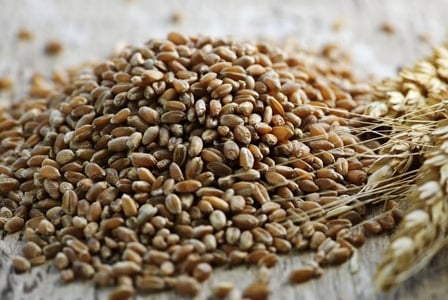
Whole grains are versatile, packed with nutrients, and they taste amazing – breakfast, lunch, and dinner.
A healthy vegetarian diet contains the following components: water; fresh fruits and vegetables; protein, such as tofu and legumes; healthy fats; and whole grains. Yes, it’s really that simple. The first two components, water and fresh produce, are pretty easy to figure out, as is protein; however, healthy fats are where it starts to get confusing, and whole grains are perhaps even more elusive.
When people think of whole grains, often what comes to mind are foods such as whole grain bread, whole grain pasta, and whole grain tortillas. And while these products are a better option than their white counterparts, they are not whole grains. Whole grains are nothing but whole grains. They include barley, spelt, wheat berries, rice, bulgur, buckwheat, whole oats, and many more. They’re versatile, packed with nutrients, and they taste amazing—breakfast, lunch, and dinner.
Why eat whole grains
Whole grains are loaded with vitamins and minerals. Most of the nutrients in whole grains are found in the bran (the protective coating), the germ (the inner nourishment), and the endosperm (the transporter). Together, this trio contains essential B vitamins, fibre, folic acid, vitamin E, magnesium, and iron. These are but a few of the key nutrients that make whole grains so important in our day-to-day diet.
As part of a disease-fighting diet, whole grains may help to lower the risk of heart disease, stroke, and even some cancers. Further, whole grains regulate blood glucose in diabetics while decreasing cholesterol and lowering blood pressure. To ensure you get the most health benefits, make sure to purchase grains that are labelled “100% whole grain.”
Sprouted grains
Recently, you may have noticed a lot of products being made with sprouted grains. You might be wondering what sprouted grains are, and why you should eat them. Typical dried whole grains are deactivated, meaning they’re waiting for the right conditions (moisture, temperature, etc.) to start their growth cycle. When that cycle is activated, enzyme activity occurs and sprouting begins. Health foodists believe that this enzyme activity makes whole grains easier to digest and makes certain vitamins and minerals more bioavailable.
Cooking with whole grains
Keep in mind that different kinds of whole grains have different cooking times. Cook whole grains until they are tender, but not mushy. To speed up cooking, soak grains at least two hours before cooking. Also, consider cooking a giant batch of whole grains, keeping them in an air-tight container in the fridge for three to four days. These pre-cooked grains can be added to stews, soups, and salads for an added nutrition boost.
This Meatless Monday, cook up one of these delicious whole-grain recipes that your family is sure to love.
- Barley Risotto
- Bulgur Stuffed Onions
- Almond Apple Millet Cereal
- Mushrooms with Wild Rice Cashew Sauce
- Barley, Vegetables, and Candied Nuts Salad
- Carrot, Cranberry, Spelt Berry Salad
- Wheat Berry and Navy Bean Salad
- Tabbouleh
- Barley and Shiitake Mushroom Dinner






